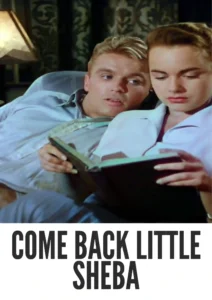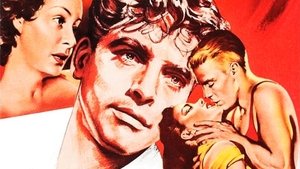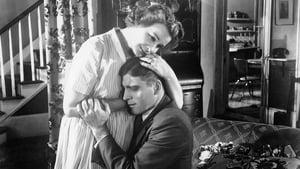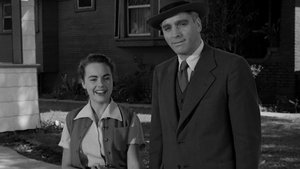Contact: [email protected]
Video Sources 0 Views
- Watch trailer
- Come Back Little Sheba


Synopsis
Table of Contents
ToggleReview: Come Back Little Sheba 1952 – A Glimpse into Domestic Turmoil

Introduction
Released in 1952, Come Back Little Sheba stands as a poignant exploration of domestic life and the complexities of human relationships. Directed by Daniel Mann, this film offers a raw and unflinching portrayal of a troubled marriage unraveling under the weight of unspoken desires and unresolved traumas. In this review, we’ll delve into how the early colorization of Come Back Little Sheba influences the viewer’s experience of this emotional drama.
Check The Full Colorized Movies List
Check Our Colorized Movies Trailer Channel
Understanding Come Back Little Sheba 1952: Director, Cast, and Genre
Directed by Daniel Mann, Come Back Little Sheba boasts a stellar cast led by Shirley Booth as Lola Delaney, a housewife longing for the return of her lost youth, and Burt Lancaster as Doc Delaney, her husband grappling with his own demons and regrets. Set against the backdrop of a quiet suburban neighborhood, the film blends elements of drama and tragedy to create a deeply affecting portrait of marital strife and longing.
Exploring the World of Come Back Little Sheba 1952: Plot and Characters
Come Back Little Sheba follows the lives of Lola and Doc Delaney as they navigate the trials and tribulations of married life. Haunted by the memory of their lost child and the dreams left unfulfilled, they struggle to find solace and meaning in their mundane existence. As they confront their own personal demons and the secrets that threaten to tear them apart, they must also reckon with the possibility of redemption and renewal.
The Art of Film Colorization
Film colorization has been a subject of much debate in the film industry. While some argue that it breathes new life into classic films and makes them more accessible to modern audiences, others contend that it compromises the artistic integrity of the original work. Regardless of one’s stance on the issue, early colorization techniques offer a fascinating glimpse into the evolving landscape of film preservation and restoration.
Early Colored Films: A Brief History
The history of early colored films is a rich tapestry of experimentation and innovation. From hand-tinted frames to pioneering technicolor processes, filmmakers have long sought to capture the vibrancy of the world on celluloid. While early color techniques may seem primitive by today’s standards, they laid the groundwork for the dazzling visual effects and digital wizardry that define modern cinema.
Come Back Little Sheba 1952 and Its Early Colored Version
The decision to release Come Back Little Sheba in a colorized format was met with both anticipation and skepticism. While some saw it as an opportunity to breathe new life into a classic domestic drama, others worried that it would detract from the film’s emotional impact and stark realism. Ultimately, whether one prefers the original black and white version or the colorized edition is a matter of personal preference. However, the colorized version offers a fresh perspective on Come Back Little Sheba, allowing audiences to see familiar scenes in a new light and perhaps discover new depths to the film’s emotional resonance.
The Debate Over Film Colorization
The debate over film colorization continues to rage on, with proponents praising its ability to make classic films more accessible to modern audiences and opponents arguing that it compromises the artistic integrity of the original work. While there may never be a clear consensus on the issue, one thing is certain: early colorization techniques offer a fascinating glimpse into the evolving landscape of film preservation and restoration.
Examining Come Back Little Sheba 1952 as an Early Colored Film
Viewing Come Back Little Sheba in its early colorized iteration offers a unique viewing experience. While the colorization adds a layer of visual richness to the film, some may argue that it detracts from the emotional impact and stark realism of the original black and white version. However, others may appreciate the opportunity to see familiar scenes in a new light, with vibrant colors enhancing the film’s visual and emotional resonance. Ultimately, whether one prefers the original black and white version or the colorized edition is a matter of personal preference.
Influence and Legacy: Come Back Little Sheba 1952’s Impact on Cinema
Come Back Little Sheba may not be as well-known as some of its contemporaries, but its impact on the cinematic landscape is undeniable. With its compelling narrative, standout performances, and timeless themes, the film has earned its place in the annals of cinematic history, inspiring filmmakers and captivating audiences for generations to come.
Director’s Cinematic Legacy: Beyond Come Back Little Sheba 1952
Daniel Mann’s directorial legacy extends far beyond Come Back Little Sheba. Throughout his career, he explored a wide range of themes and genres, crafting a body of work that continues to resonate with audiences to this day. His keen insight into the human condition and his ability to capture the complexities of human relationships make him a true master of his craft.
Themes Explored in Come Back Little Sheba 1952
At its core, Come Back Little Sheba explores themes of longing, regret, and the search for meaning in a world filled with disappointment and disillusionment. Through its compelling narrative and richly drawn characters, the film offers a poignant meditation on the fragility of human relationships and the enduring power of hope.
Reception and Controversy Surrounding Come Back Little Sheba 1952
The release of the colorized version of Come Back Little Sheba sparked a flurry of debate among critics and audiences alike. While some praised the film’s newfound visual splendor, others lamented the loss of its stark realism and emotional resonance. Despite the controversy, the film remains a compelling testament to the power of storytelling and the enduring appeal of classic cinema.
Where to Watch Come Back Little Sheba 1952 Online
For those eager to experience Come Back Little Sheba for themselves, the film is readily available on popular streaming platforms such as Netflix, Amazon Prime, and Hulu. Whether viewed in its original black and white format or its early colorized iteration, Come Back Little Sheba continues to captivate audiences with its gripping narrative and richly drawn characters, cementing its status as a true classic of the silver screen.
FAQs About Come Back Little Sheba 1952
1. Is Come Back Little Sheba based on a true story?
Come Back Little Sheba is a work of fiction inspired by real-life experiences and observations. While the film’s storyline is not directly based on a specific true story, it draws inspiration from the complexities of human relationships and the struggles faced by individuals in domestic life.
2. Who directed Come Back Little Sheba?
Come Back Little Sheba was directed by Daniel Mann, a visionary filmmaker known for his keen insight into the human condition and his ability to capture the complexities of human relationships on screen. Mann’s masterful direction and the film’s compelling narrative elevate it to cinematic greatness, making it a standout example of his directorial prowess.
3. What is the central conflict of Come Back Little Sheba?
At its core, Come Back Little Sheba revolves around the central conflict between longing and regret. As Lola and Doc Delaney grapple with their own personal demons and the secrets that threaten to tear them apart, they must confront the painful realities of their past and the choices that define them.
4. What sets Come Back Little Sheba apart from other domestic dramas of its time?
Come Back Little Sheba stands out from other domestic dramas of its time due to its raw and unflinching portrayal of marital strife and longing. While it may lack the grandiose spectacle of other Hollywood productions, its intimate focus on the struggles of everyday life makes it a deeply affecting and emotionally resonant film.
5. What is the significance of the film’s early colorized version?
The early colorized version of Come Back Little Sheba offers audiences a fresh perspective on a classic domestic drama, allowing them to see familiar scenes in a new light. While some purists may prefer the original black and white version, the colorized edition provides an opportunity to experience the film’s emotional resonance in a new way.
6. How does the colorization process affect the film’s emotional impact?
The colorization process adds a layer of visual richness to Come Back Little Sheba, enhancing the film’s overall emotional resonance. However, some purists argue that it detracts from the stark realism and emotional depth of the original black and white version. Ultimately, whether one prefers the original black and white version or the colorized edition is a matter of personal preference.
7. What is the legacy of Come Back Little Sheba?
Come Back Little Sheba may not be as well-known as some of its contemporaries, but its impact on the cinematic landscape is undeniable. With its compelling narrative, standout performances, and timeless themes, the film has earned its place in the annals of cinematic history, inspiring filmmakers and captivating audiences for generations to come.
8. Are there any sequels or remakes of Come Back Little Sheba?
While there are no direct sequels or remakes of Come Back Little Sheba, the film’s enduring legacy can be seen in the countless domestic dramas that have followed in its wake. Its exploration of themes of longing, regret, and the search for meaning continues to resonate with audiences to this day, cementing its status as a true classic of the silver screen.
9. Where can I watch Come Back Little Sheba online?
For those eager to experience Come Back Little Sheba for themselves, the film is readily available on popular streaming platforms such as Netflix, Amazon Prime, and Hulu. Whether viewed in its original black and white format or its early colorized iteration, Come Back Little Sheba continues to captivate audiences with its gripping narrative and richly drawn characters, cementing its status as a true classic of the silver screen.
Conclusion
In conclusion, Come Back Little Sheba remains a powerful testament to the complexities of domestic life, regardless of its colorized iteration. While the debate over film colorization continues to rage on, one thing remains clear: Daniel Mann’s masterful direction and the film’s compelling narrative elevate Come Back Little Sheba to cinematic greatness. Whether viewed in its original black and white format or its early colorized version, the film continues to captivate and provoke thought, making it a true classic of domestic drama. As audiences continue to revisit this cinematic gem for generations to come, its legacy will endure, inspiring countless filmmakers and captivating audiences with its timeless exploration of longing, regret, and the search for meaning in a world filled with disappointment and disillusionment.











